Linkage with SCM system
Overview
Next Design works with Subversion, a configuration management system, to allow you to complete a series of file operations on the configuration management repository with UI operations on Next Design.
The following describes the operations of Next Design working with the configuration management repository in the following order:
- Get a project from the repository and open it
- Get editing permission and start editing
- Release editing permission
- Get the latest from the repository
- Cancel and revert changes
- Commit changes and update the repository
- View the commit log
- Register a project in the repository
- Manage the repository to be used
- Please prepare a configuration management repository to work with Next Design in advance.
Retrieve and open a project from a repository
To retrieve and open a project from a repository, follow the steps below from the Next Design start page.
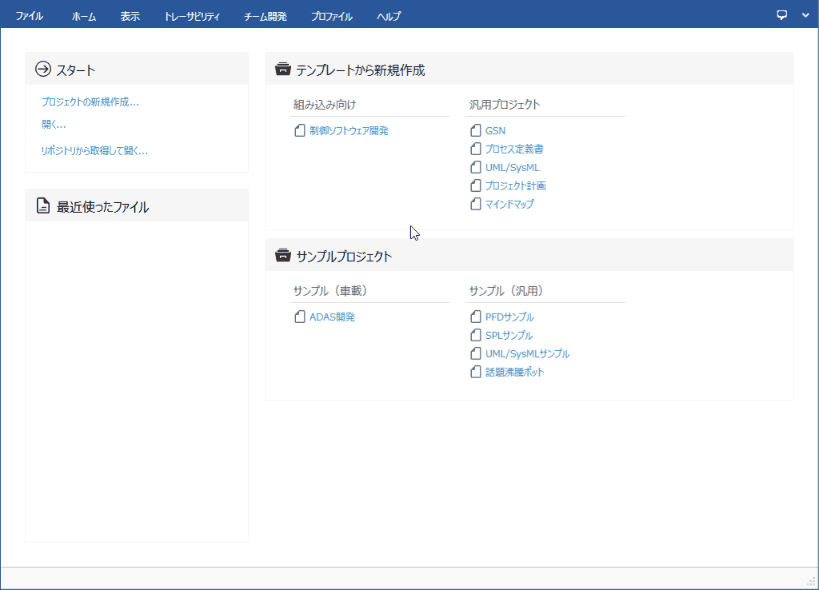
- Click [Start] > [Open a Project from the repository...] to display the [Repository Selection] dialog.
- Select the repository where the project is stored using one of the following methods and press the [Next] button.
- If this is the first time you are using a configuration management repository in Next Design, or if the configuration management repository where the project is stored has not been registered, register the repository using the following steps.
(1) Select [Register a new Repository] and press the [Next] button.
(2) Enter the connection information for the configuration management repository and press the [Next] button. - If the configuration management repository where the project is stored has already been registered, select that repository and press the [Next] button.
- Select the project file to retrieve using one of the following methods.
- Select the project from the project list displayed on the [Select Project File] tab.
- Switch to the [Select from Folder] tab and select the folder where the project file (.iproj) is stored from the folder tree displayed.
- Specify the destination folder for the project file in [Check out to] and click [Check out].
- If the project file is successfully retrieved, the project file will open.
- Specify a new, empty folder as the destination folder.
Acquire editing permissions and start editing
To acquire editing permissions and start editing, follow the steps below.
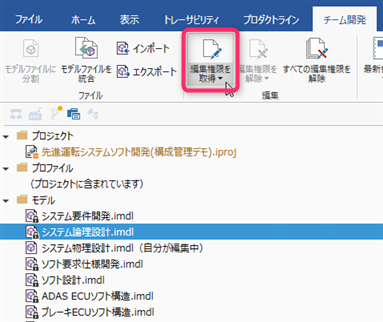
- Select the project or model file you want to start editing in one of the following ways.
- Select the file in the project navigator.
- Select the project or model in the model navigator.
- Start editing in one of the following ways.
- Click [Team Collaboration] > [Edit] > [Get edit permission]/[Get Edit Permission below Selected Model]/[Get all edit permission] from the ribbon.
- Click [Get edit permission] from the context menu.
- When you start editing, the model file icon will change, and the model file will be marked as [(Editing by you)] in the project navigator.
Cancel editing permission
To cancel editing permission, follow the steps below.
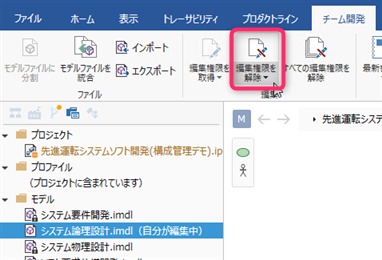
To release edit permission for a specified file
- Select the project or model file for which you want to release edit permission in one of the following ways.
- Select the project or model in the model navigator that is being edited.
- Select the file in the project navigator that is being edited.
- Select the file in the configuration management navigator that is being edited.
- Release edit in one of the following ways.
- Click [Team Collaboration] > [Edit] > [Release edit permission]/[Release Edit Permission below Selected Model] from the ribbon.
- Click [Release edit permission] from the context menu.
To release edit permission for all files at once
- Click [Team Collaboration] > [Edit] > [Release All Edit Permission] from the ribbon.
- If you release the editing permission without committing the changes from the Configuration Management Navigator, the modified file will remain and will be inconsistent with the repository.
- To align with the repository, please undo the changes by following the procedure described below in "Undoing and Undoing Changes".
Get the latest from the repository
To update a file previously retrieved from the repository to the latest revision, follow the steps below.
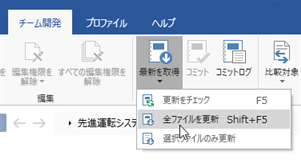
To check if it has been updated since it was retrieved previously
- From the ribbon, click [Team Collaboration] > [Sync Repository] > [Get the Latest], and then click [Check for updates].
To update all files to the latest revision
- Update to the latest revision using one of the following methods.
- Click the icon of [Team Collaboration] > [Sync Repository] > [Get the Latest] on the ribbon.
- Click the [▼] at the bottom of [Team Collaboration] > [Sync Repository] > [Get the Latest] on the ribbon, and click [Get All Files].
To update a specified file to the latest revision
- Select the project or model file to update to the latest revision in one of the following ways.
- Select the project or model in the model navigator.
- Select the project file or model file in the project navigator.
- Update to the latest revision in one of the following ways.
- Click the [▼] at the bottom of [Team Collaboration] > [Sync Repository] > [Get the Latest] on the ribbon, and click [Update Selected File Only].
- Click [Get the latest version of selected File] from the context menu.
- Files that have been modified since the acquisition are ignored, and other files are updated to the latest revision.
Undoing and reverting changes
To undo changes in uncommitted files and revert to the original revision, follow the steps below.
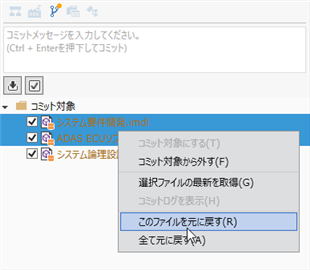
To revert changes in all files
- Switch the navigator to the configuration management navigator.
- Click [Revert All] from the [Commit Target] context menu.
- When a dialog box appears asking you to confirm whether to reload the project, click the [Yes] button.
To revert changes in a specified file
- Switch the navigator to the configuration management navigator.
- Select the file for which you want to revert the changes from [Commit Target] in the Configuration Management Navigator.
- Click [Revert This File] from the context menu.
- When the confirmation dialog to reload the project appears, click the [Yes] button.
- Editing permissions for the file for which changes have been reverted are removed.
- If you want to continue editing, obtain editing permissions again and start editing.
- Changes that have already been committed cannot be undone in Next Design.
Commit changes and update the repository
To commit changes to a file and update the repository, follow the steps below.
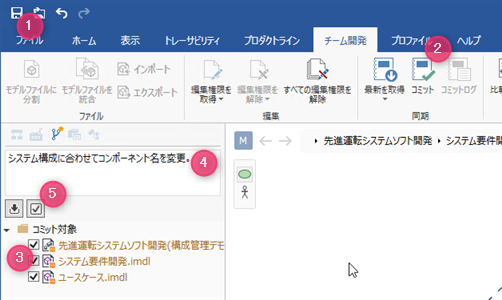
- Save the changed file.
- Switch to the Configuration Management Navigator using one of the following methods.
- Click [Team Collaboration] > [Sync Repository] > [Commit] from the ribbon.
- Click [Change Navigator] from the selector at the top of the Navigator.
- Check the files displayed in [Commit Target]. By default, all changed files are checked as the commit target. If you want to exclude some files from the commit target, uncheck them.
- Enter a commit message.
- After entering the commit message, click the [Commit] button below the input field or press ctrl+enter.
- This updates the files in the repository and adds a commit log.
- If there are files that have been changed and saved but not committed, a mark will be displayed on the icon in the configuration management navigator.
- The icons of files that have not been committed will be marked with a change mark.
- If you check the [Keep editable state] checkbox at the bottom of [Commit Target] before committing, you can continue editing each file while retaining the edit permission.
(Edit permission is not maintained when changing the hierarchy or name of a model file, which changes the file path.) - By default, this checkbox is unchecked, and edit permission is released at the same time as committing.
- The changed file will not be displayed in [Commit Target] until it is saved.
- Save it before committing.
- If you are working with Subversion, you must commit each change when changing the hierarchy or name of a model file.
If you try to edit continuously without committing, a message will be displayed prompting you to obtain edit permission for the required model file, but even if you follow the message and try to obtain edit permission for the model file, an error will occur during configuration management operation and you will not be able to obtain it.
Please commit the changes or revert the changes before editing.
Show commit log
To show the commit log for a file, follow the steps below.
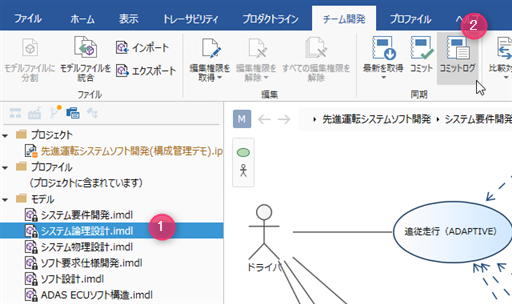
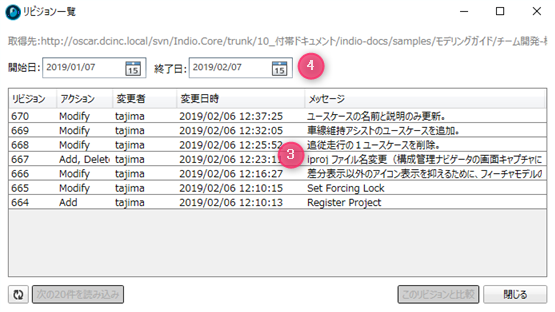
- Select the project or model file for which you want to show the commit log in one of the following ways:
- Select the file in the project navigator.
- Select the project or model in the model navigator.
- Select the file in the configuration management navigator.
- Display the commit log in one of the following ways:
- Click [Team Collaboration] > [Sync Repository] > [Commit Log] from the ribbon.
- Click [Show commit log] from the context menu.
- The [Log Messages] dialog box appears, displaying a list of commit logs for each revision.
- You can filter the list of commit logs by specifying the start and end dates.
Register a project to a repository
To register a new project that is not registered in the repository, follow the steps below.
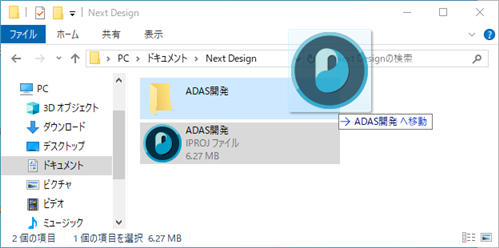

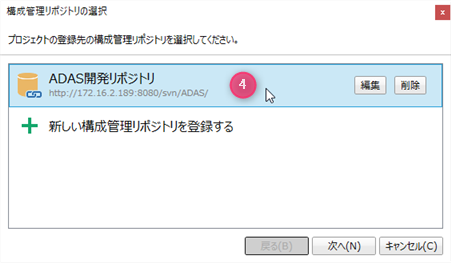
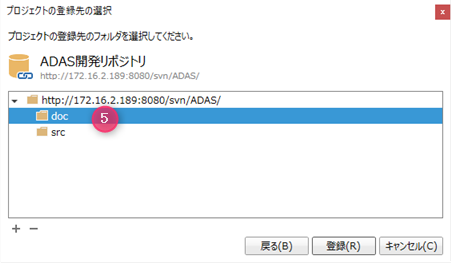
- Create a folder with the same name as the folder to be added to the repository, and move the project files and other set of files to it.
- Open the project file in Next Design.
- From the ribbon, click [Team Collaboration] > [Repository] > [Registration to Repository].
- Select the repository where you want to store the project using one of the following methods and press the [Next] button.
- If you are using the configuration management repository in Next Design for the first time, or if the repository has not been registered, register the repository using the following procedure.
- Select [Register a new Repository] and press the [Next] button.
- Enter the connection information for the configuration management repository and press the [Next] button.
- If the repository has already been registered, select that repository and press the [Next] button.
- Select the folder where you want to store the project folder and click [Register].
- If the repository registration is successful, the Configuration Management Navigator will be available as a navigator option.
- Be sure to register the repository on Next Design.
- If you register a repository using a Subversion client tool other than Next Design, Next Design's configuration management system integration function may not work properly.
- Immediately after registering a repository, you will be in a state where you have started editing the set of registered files.
- If you do not want to continue editing after registering the repository, cancel the editing permissions.
Manage the repositories you use
To register a configuration management repository in Next Design or change the connection information that has already been registered, follow the steps below.

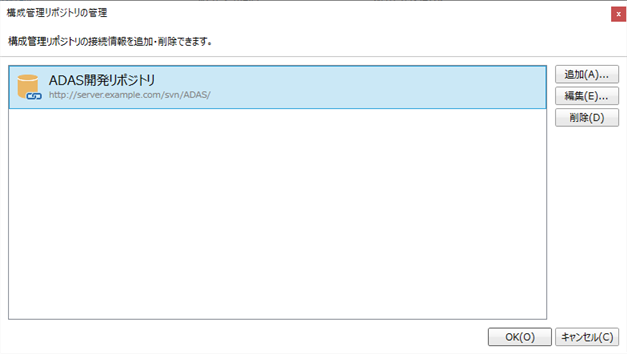
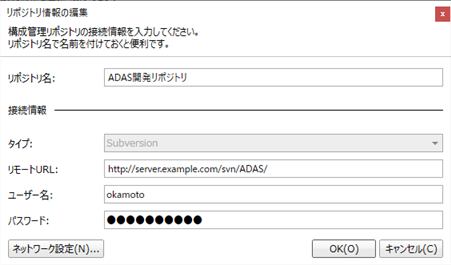
- From the ribbon, click [Team Collaboration] > [Repository] > [Repository Management] to display the [Repository Management] dialog.
- To register a new repository, press the [Add] button, then enter the repository connection information in the [Editing Repository Setting] dialog, and press the [Add] button.
- To change the connection information of a registered repository, select the registered repository and press the [Edit] button, then edit the repository connection information in the [Editing Repository Setting] dialog, and press the [OK] button.
- To delete a registered repository, select the registered repository, click the [Delete] button, and then click the [OK] button in the confirmation message.
- To confirm the above changes, click the [OK] button in the [Repository Management] dialog.